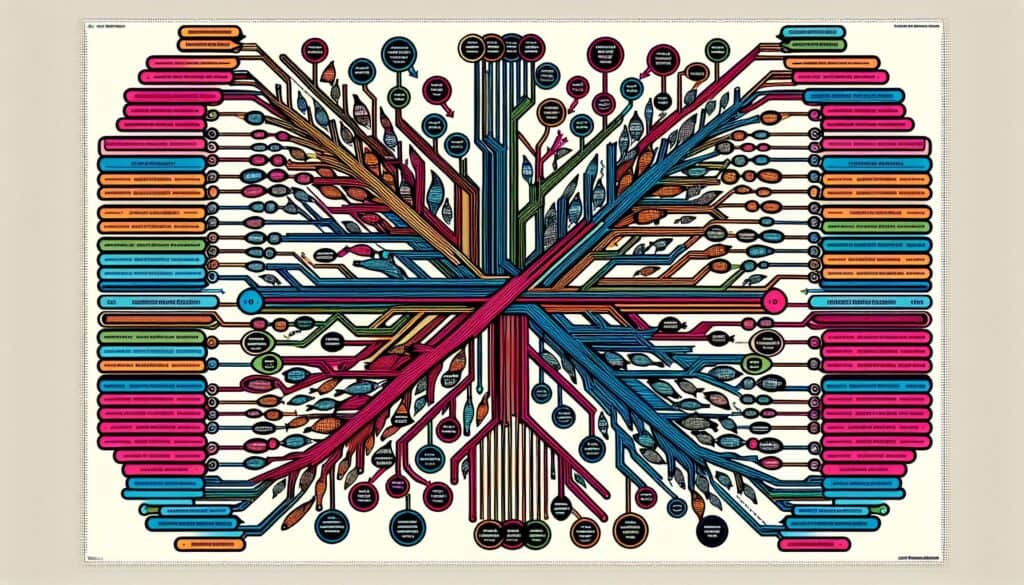To visually brainstorm and categorize the potential causes of a specific problem (the “effect”) to identify its root causes.
- Methodologies: Customers & Marketing, Lean Sigma, Product Design
Fishbone Diagram (Ishikawa Diagram)

Fishbone Diagram (Ishikawa Diagram)
- Brainstorming, Continuous Improvement, Problem Solving Techniques, Process, Quality Management, Root Cause Analysis, Teamwork, Value Stream Mapping
Objective:
How it’s used:
- The problem (effect) is written at the "head" of the fish. Main categories of causes (e.g., People, Process, Equipment, Materials, Environment, Management - or others relevant to the context) form the "bones." Teams brainstorm specific causes within each category.
Pros
- Provides a structured way to brainstorm a wide range of potential causes; Visually organizes complex causal relationships; Encourages team participation and diverse perspectives; Helps to look beyond obvious symptoms.
Cons
- Can become very complex and cluttered for multifaceted problems; Does not inherently quantify the impact of different causes; The identified causes are potential and require further investigation and validation.
Categories:
- Ideation, Lean Sigma, Manufacturing, Problem Solving, Quality
Best for:
- Brainstorming and exploring all potential causes of a specific problem in a structured, visual way.
The Fishbone Diagram, or Ishikawa Diagram, is particularly useful in industries such as manufacturing, healthcare, and software development for identifying root causes of quality issues. Commonly employed during the analysis phase of problem-solving, teams typically initiate this methodology during brainstorming sessions that draw participants from diverse functions including engineering, quality assurance, operations, and management. By categorizing causes into defined groups such as People, Process, Equipment, Materials, Environment, and Management, teams can explore not just immediate factors but also underlying systemic issues contributing to a problem. This structured approach encourages collaborative input from all members, fostering a culture of engagement and shared responsibility in troubleshooting. For instance, in a product development setting, a Fishbone Diagram might be used to dissect delays in a project timeline, allowing teams to systematically address challenges ranging from resource allocation to communication breakdowns. The diagram’s visual representation enables stakeholders to grasp the interconnections among various causes, making it a practical tool for continuous improvement initiatives or root cause analysis in six sigma projects, enhancing the quality of products and services delivered. This method can be beneficial in various scenarios, such as during the review of customer feedback regarding product defects or when addressing inefficiencies in operational workflows, ensuring a comprehensive exploration of potential sources of problems while steering clear of symptomatic fixes.
Key steps of this methodology
- Identify and clearly define the problem or effect at the head of the diagram.
- Select main categories of causes relevant to the specific issue.
- Draw lines representing each category as main branches from the spine of the fish.
- Conduct a brainstorming session for each category to identify specific causes.
- Add sub-branches for each specific cause that emerge from the main branches.
- Encourage discussion and refine causes for clarity and relevance.
- Review the diagram for completeness and ensure all potential causes are represented.
Pro Tips
- Utilize a pre-brainstorming survey to gather initial thoughts, ensuring all team members contribute before the meeting.
- Incorporate different fishbone diagrams for various categories to prevent overlapping thoughts and enhance clarity.
- Facilitate a second round of discussion where teams prioritize causes based on impact and likelihood, refining the direction for further analysis.
To read and compare several methodologies, we recommend the
> Extensive Methodologies Repository <
together with the 400+ other methodologies.
Your comments on this methodology or additional info are welcome on the comment section below ↓ , so as any engineering-related ideas or links.
Historical Context
1962
1970
1972
1980
1980
1986
1986
1960
1963
1970
1980
1980
1980
1986
1987
(if date is unknown or not relevant, e.g. "fluid mechanics", a rounded estimation of its notable emergence is provided)















Related Posts
Musculoskeletal Discomfort Questionnaires
Multivariate Testing (MVT)
Multiple Regression Analysis
Motion Capture Systems
MoSCoW Method
Mood’s Median Test